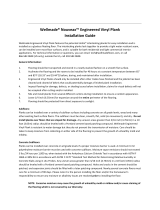Page is loading ...

-
MPN(s): 8RBBRFL_Y, 8RBBRFL_R, 8RBBRFL_GY, 8RBBRFL_BL, 8RBBRFL_BK
SKU(s): 409015, 409017, 409014, 409016, 409013
UPC(s): 719318385258, 719318385265, 719318385296, 719318385241, 719318385203

2
There are different methods one can use to install rubber flooring. This installation guide will
describe how to install your rubber flooring with either double-sided tape or glue. Before
installation, we recommend that you have the following:
• Glue/Double-sided tape (depending on which method of installation you choose)
• Rubber flooring
• Carpet roller
• Utility knife
• Straight edge
DOUBLE-SIDED TAPE:
1. Clean your subfloor. It needs to be free of dirt, dust, grease, and debris.
2. Make sure your subfloor is dry.
3. Lay the rubber flooring down to make sure you are okay with the look of the flooring.
4. Use the utility knife and straight edge if you get to the wall and need to cut away excess
rubber flooring.
5. Apply double-sided tape to the bottom/perimeter of the rubber flooring. Remove the
release paper. Apply pressure when laying the rubber flooring.
6. After the adhesive has set for an hour, use a carpet roller on the rubber flooring. If you
do not have a carpet roller, stomp on the rubber flooring.

3
GLUE:
1. Clean your subfloor. It needs to
be free of dirt, dust, grease, and
debris.
2. Make sure your subfloor is dry.
3. Lay the rubber flooring down to
make sure you are okay with the
look of the flooring.
4. Use the utility knife and straight
edge if you get to the wall and
need to cut away excess rubber
flooring.
5. Apply double-sided tape to the
bottom/perimeter of the rubber
flooring. Remove the release paper. Apply pressure when laying the rubber flooring.
After the adhesive has set for an hour, use a carpet roller on the rubber flooring. If you
do not have a carpet roller, stomp on the rubber flooring.
6. Roll the rubber flooring to one side of the room. Apply a thin layer of glue to the section
of the subfloor that will be covered by your first strip of rubber flooring. Unroll your first
strip of rubber flooring and firmly press it into the glue. Repeat this step for each strip of
rubber flooring until all of your pieces have been set.
7. Once the rubber flooring has been set, use a carpet roller on the rubber flooring. If you
do not have a carpet roller, stomp on the rubber flooring.
/





